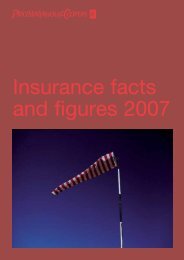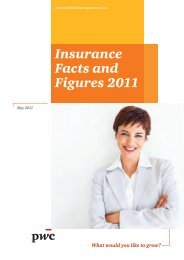Controlling fraud in the public sector - PricewaterhouseCoopers
Controlling fraud in the public sector - PricewaterhouseCoopers
Controlling fraud in the public sector - PricewaterhouseCoopers
Create successful ePaper yourself
Turn your PDF publications into a flip-book with our unique Google optimized e-Paper software.
Fraud risk management<br />
and assessments<br />
Accord<strong>in</strong>g to <strong>the</strong> PwC Global Economic Crime Survey,<br />
although most (61%) of government and state-owned<br />
enterprises had performed a <strong>fraud</strong> risk assessment dur<strong>in</strong>g<br />
<strong>the</strong> year, this detected only 5% of <strong>fraud</strong>s.<br />
A report prepared by <strong>the</strong> New South Wales Auditor-<br />
General <strong>in</strong> 2010 and submitted to State Parliament found<br />
that of <strong>the</strong> 57 agencies and universities, most thought <strong>the</strong>y<br />
had an effective <strong>fraud</strong> control policy. However:<br />
• 22 respondents (39%) rated <strong>the</strong>ir <strong>fraud</strong> risk<br />
assessment processes and employee awareness<br />
programs as “less than effective”<br />
• 23 respondents (40%) rated <strong>the</strong>ir detection<br />
systems as “less than effective” 17<br />
While 91% of Commonwealth agencies reported to <strong>the</strong> AIC<br />
that <strong>the</strong>y had completed a <strong>fraud</strong> risk assessment 18 , <strong>the</strong> ANAO<br />
survey reported that of <strong>the</strong> 160 Commonwealth agencies,<br />
only 54% stated <strong>the</strong>ir <strong>fraud</strong> prevention and detection<br />
strategies were effective. The o<strong>the</strong>r 46% of agencies had<br />
not evaluated <strong>the</strong> effectiveness of <strong>the</strong>ir strategies. 19<br />
While <strong>the</strong>re is an argument that risk management and<br />
appropriate controls may mitigate <strong>the</strong> risk of <strong>fraud</strong>, <strong>the</strong><br />
fact that <strong>the</strong> <strong>public</strong> <strong>sector</strong> reported higher overall <strong>fraud</strong><br />
than o<strong>the</strong>r <strong>in</strong>dustries suggests governments could make<br />
improvements <strong>in</strong>clud<strong>in</strong>g those recently specified <strong>in</strong> <strong>the</strong><br />
Commonwealth Fraud Control Guidel<strong>in</strong>es such as:<br />
• adopt<strong>in</strong>g more thorough <strong>fraud</strong> risk assessments to<br />
identify a range of risks<br />
• updat<strong>in</strong>g and review<strong>in</strong>g <strong>fraud</strong> assessments with any<br />
change <strong>in</strong> <strong>the</strong> bus<strong>in</strong>ess, such as <strong>the</strong> addition of a new<br />
structure or bus<strong>in</strong>ess unit, 20 deployment of a new<br />
program, 21 heightened risk or a change <strong>in</strong> <strong>in</strong>cident levels<br />
• address<strong>in</strong>g identified risks by correspond<strong>in</strong>g <strong>fraud</strong><br />
prevention plan strategies.<br />
The practice of simply “review<strong>in</strong>g” old <strong>fraud</strong> risk<br />
assessments and <strong>fraud</strong> control plans <strong>in</strong> order to save<br />
money is unlikely to be a robust prevention strategy.<br />
Fraud risk assessment<br />
In our experience and based on <strong>the</strong> recently<br />
released Commonwealth Fraud Control Guidel<strong>in</strong>es,<br />
a comprehensive <strong>fraud</strong> risk assessment should:<br />
• identify <strong>the</strong> potential <strong>in</strong>herent <strong>fraud</strong> risks<br />
• assess <strong>the</strong> likelihood and significance of <strong>the</strong><br />
identified risks occurr<strong>in</strong>g<br />
• identify exist<strong>in</strong>g preventative and detection<br />
controls and map <strong>the</strong>m to <strong>the</strong> relevant <strong>fraud</strong> risks<br />
• evaluate whe<strong>the</strong>r relevant controls and<br />
processes are designed to address identified<br />
<strong>fraud</strong> risks effectively<br />
• identify and evaluate residual <strong>fraud</strong> risks<br />
result<strong>in</strong>g from <strong>in</strong>effective or non-existent controls<br />
• assign <strong>in</strong>dividual responsibility to manage and<br />
respond to residual <strong>fraud</strong> risks<br />
• update <strong>fraud</strong> risk assessments at least every<br />
two years and more frequently as new<br />
programs and <strong>in</strong>itiatives are <strong>in</strong>troduced.<br />
17 NSW Auditor-General Fraud Control Report page 6<br />
18 Australian Institute of Crim<strong>in</strong>ology Fraud aga<strong>in</strong>st <strong>the</strong> Commonwealth 2008-2009 Annual Report to Government 4 April 2011, page 16<br />
19 ANAO Fraud Control Report, page 16<br />
20 Commonwealth Fraud Control Guidel<strong>in</strong>es 2011, paragraph 6.8<br />
21 Commonwealth Fraud Control Guidel<strong>in</strong>es 2011, paragraph 6.9<br />
Fight<strong>in</strong>g <strong>fraud</strong> <strong>in</strong> <strong>the</strong> <strong>public</strong> <strong>sector</strong> 15
















